In a recent report we released in association with the Retail Gazette, over 110 organisations from their UK readership were surveyed. It was found the retail industry had seen the equivalent of five years of change over the 12-month period of this pandemic.
So, if retail is a bellwether for the rest of us, what have these retailers experienced that the rest of us can learn from and use to help our own industries?
- Working from home is a top challenge
- While customer recruitment is still vital, customer retention is a bigger priority
- Technology adoption is seen as 'the answer'
- As well as e-commerce technology, businesses want to invest in customer engagement, internal productivity and digital marketing…
- …and this is a higher priority than business intelligence and analytics
Working from home is a top challenge
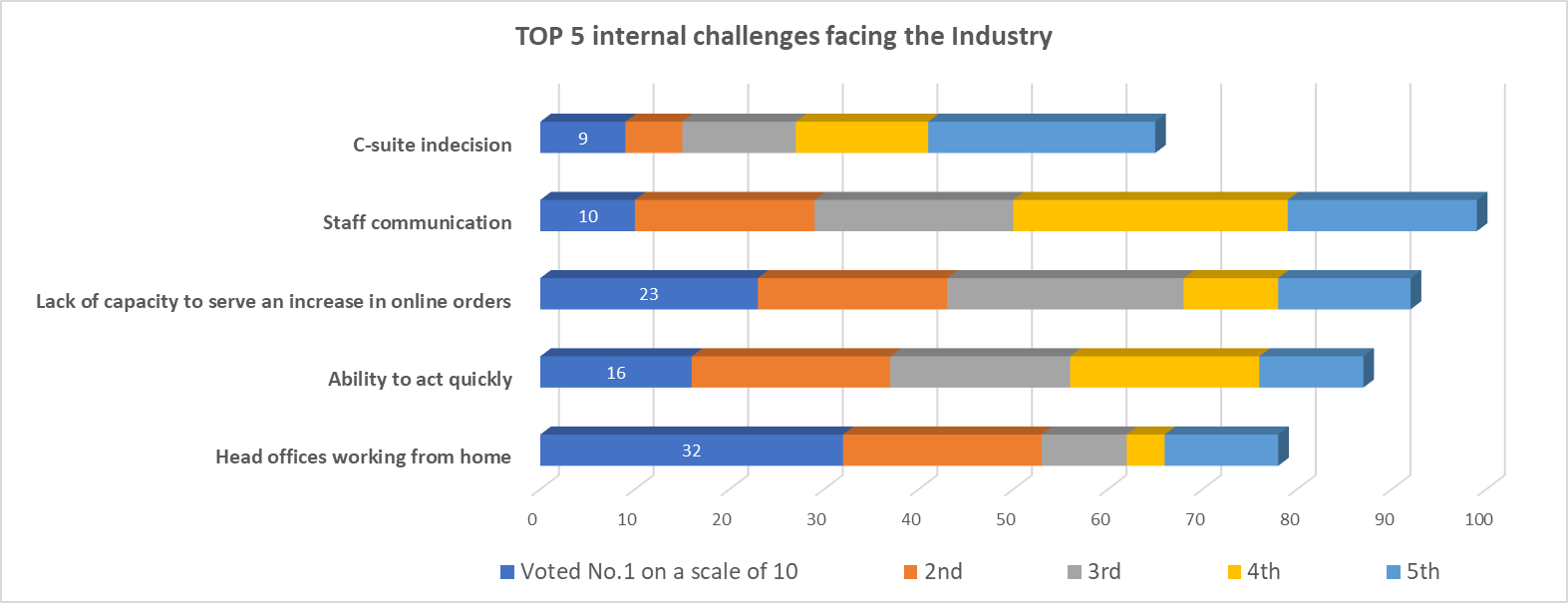
Clearly, the “working from home” issue is at the top of most business leaders’ minds having been voted No.1 or No.2 by most people surveyed. The obvious next issue? The “lack of capacity” to address the stellar rise in online ordering.
I suppose one could argue that “staff communication” and “working from home” are related and certainly not unique concerns to retailers as it clearly has affected most UK industries. This is where the online communication technologies like Zoom and Teams really came into their own. They’ve joined the mainstream of the IT tools we now all expect to just “be there” in every walk of life and at work.
Customer communication has increased
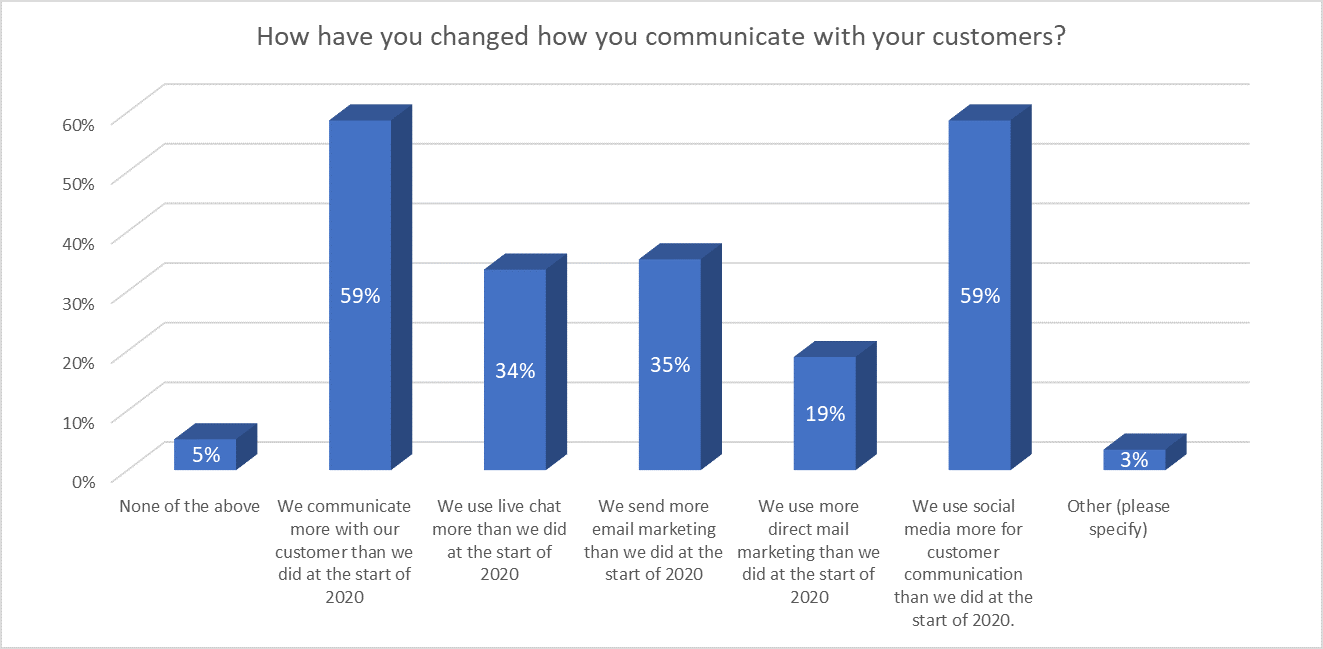
Nearly 60% of respondents have increased their customer communication and are doing this by increasing their use of social media (59%), email communications (35%) and live chat (34%).
For those in retail, this is a trend that was happening already. But what has happened now is that they have completely adapted to the new economic trend in less than 12 months!
As I mentioned earlier, if retail is a bellwether for the rest of us, then this “consumer style” digital experience will soon transfer over to other industries. Particularly as people start to expect the same service experience from their B2B partners and suppliers at work.
So how have the retailers addressed this change in demand?
While customer recruitment is still vital, customer retention is a bigger priority
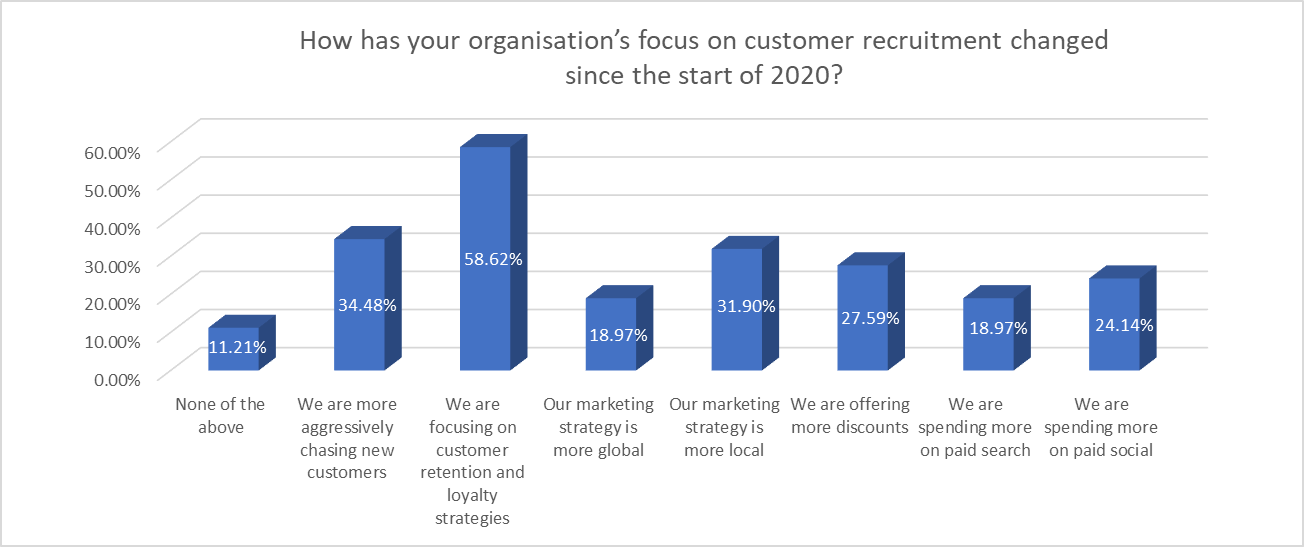
There’s a very clear focus on customer retention (58%) and aggressive new customer tactics (32%). Combined with marketing becoming more localised, we can see that they mean to adjust their marketing efforts to create more personalised messaging to their customers and prospects.
There’s no reason to believe that other industries are not thinking exactly the same way, right now.
If your competitors are now aggressively targeting new customers, they must, by definition, be targeting someone’s else’s customer. Maybe yours! So, keeping hold of your own customer base will surely be the TOP priority if your business is not to be cannibalised by your competitors.
To use a sporting analogy from fencing, the ‘lunge’ represents aggressively targeting new customer demands and the ‘parry’ represents effective customer retention services. Do this immediately… for your very survival.
If the customer retention isn’t put in place quickly enough, the lunge may penetrate deep enough to be immediately fatal or at least mortally wounding to the business. It’s clear our retail colleagues can see that, so how are they addressing this?
Technology adoption is seen as ‘the answer’
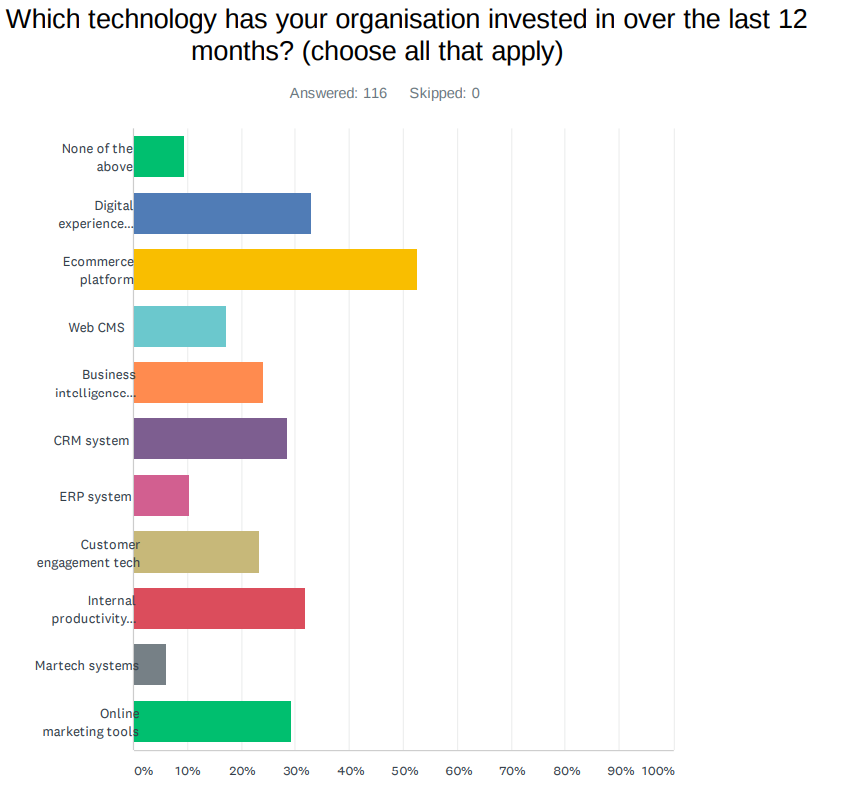
52% have invested in new e-commerce platform technologies and 33% in digital experience. These are clearly aimed at making it easier for people to buy from them and give their customers, new and existing, an improved, more convenient digital experience.
Of course, in retail, these activities are a higher priority for the leadership community than they might be for some other industries. However, they’re lighting the way for the rest of us.
Coming up third highest was the investment in internal productivity tech (e.g. staff communication platform, project management tools, etc). Now, I think this is third because as we already know, this was largely addressed very early on in the pandemic - it was critical to everyone in the panic of the first lockdown.
Happily, the collaboration technologies, like Zoom and Teams, came the rescue and resolved that very effectively early on. So, I would expect no-one is surprised this was high on last years’ list of investments. If you had asked this survey question in April 2020, I bet it would have be No.1 by far.
High on the list of investment last year are online marketing tools and CRM systems. So that suggests that even the retailers are now looking for even closer, more personalised relationships with their customers. It’s not just about market share anymore.
As well as e-commerce technology, businesses want to invest in customer engagement, internal productivity and digital marketing…
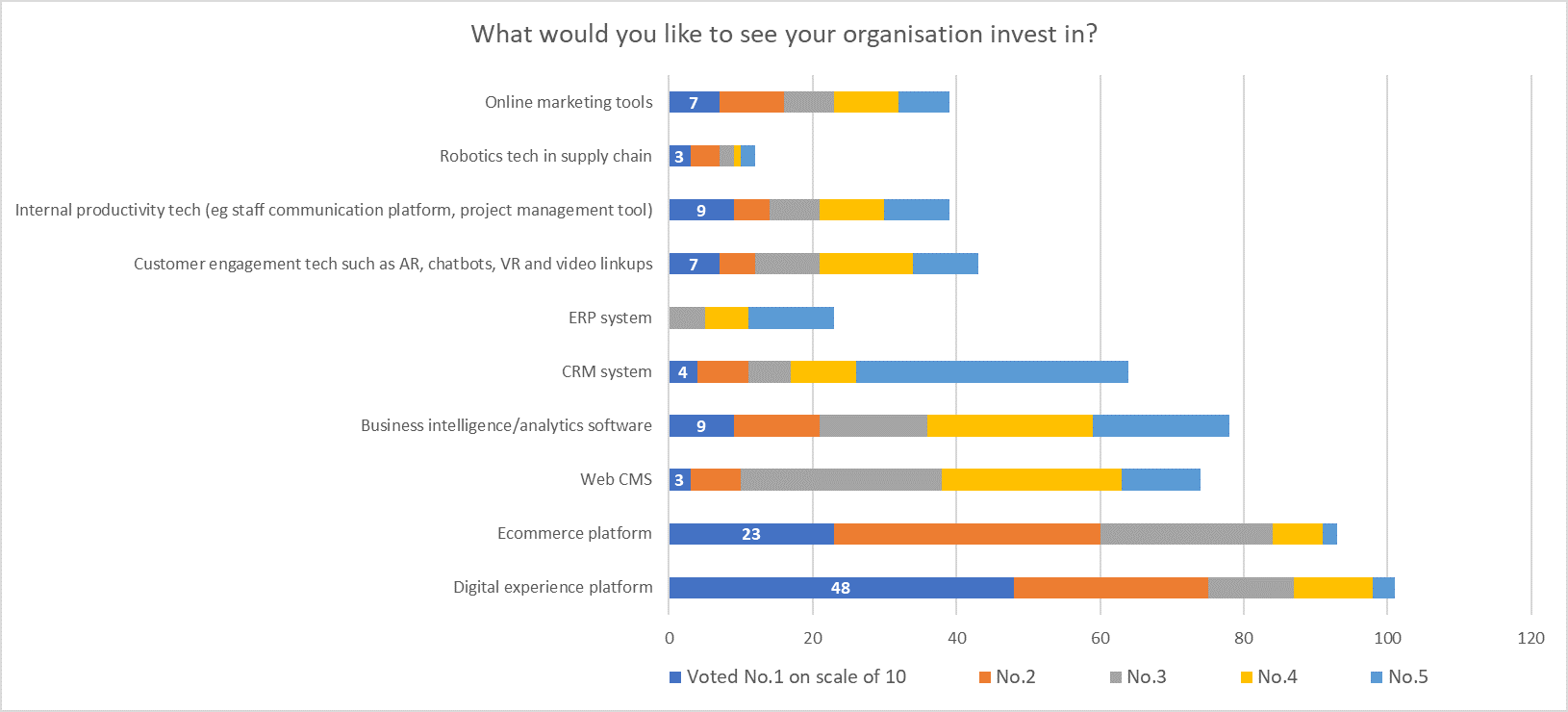
As a retail audience with a very B2C orientation, the top three are all the web and online purchasing technologies. Let’s look past those more B2C-type topics and at the more industry generic trends. Business intelligence/analytics and CRM clearly stand out again for this year, with customer engagement technologies, internal productivity and online marketing tools emerging.
What businesses are expecting to actually invest in is slightly different though…
…and this is a higher priority than business intelligence and analytics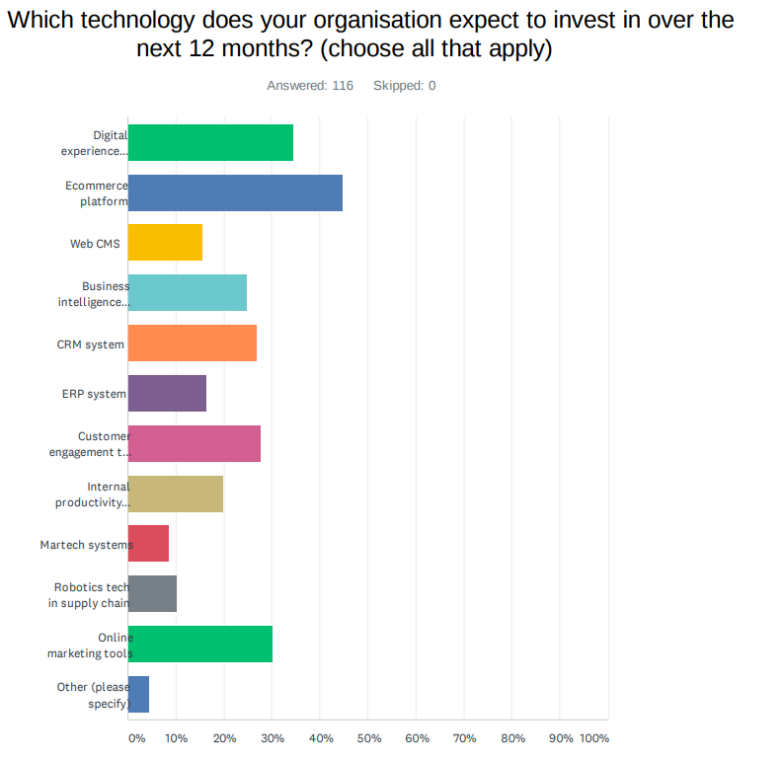
Yes, there will be continued focus on the e-commerce and digital experience in retail organisations. For those not so close to the consumer, the investment roadmap here suggests that online marketing (30%), customer engagement tech such as AR, chatbots, VR and video chat (28%) and CRM (27%) all surpass Business intelligence and internal productivity as the next three strategic investment areas by expected priority.
Now the good news is that all these areas can be piloted at very low cost and in very short timescales. So you can validate your return on investment before rolling out the benefits to the organisation as a whole.
For instance, all of these are available as SaaS offerings with minimal commitment.
Introducing ‘online marketing’ technology to your organisation covering emails, events, customer journeys, newsletters etc. can be achieved in as little as a three-week project using something like ClickDimensions or Microsoft Marketing suite, amongst others.
There are a variety of useful benefits CRM systems that can offer you:
- Real 360° views of your customers
- Can be linked to your Office 365 and email systems
- Interact with your online marketing tools
- Connect with your customer service and mobile field service operations
And if you’re really looking to maximise, you can even connect to your customers’ equipment via the Internet of Things (IoT). This will automatically update your field service teams with service-related data and issues… if you wish to go that far. None of this has even touched your ERP solution.
What I’m saying is, you can definitely start small, test, prove and expand the benefits of online marketing or CRM to your business in a low investment, low risk, quick win scenario.
This is exactly what we’ve noticed with some of our customers. In this recent pandemic, we’ve noticed that a number of organisations have taken the opportunity to review their IT infrastructure. In fact, quite a few customers are now choosing to implement CRM first ahead of a potentially more disruptive ERP project.
This allows them to use CRM or online marketing to really test the cloud environment and get used to the freedom before they commit to moving their complex “ERP system of record” along a similar journey to the cloud. And actually, that’s a very sensible plan, because you can achieve a great deal this way - all without intruding on your complex ERP.

Here are 10 examples of the popular ROI-related benefits for CRM that we see...
High benefit amount areas (quantifiable £’s):
- Improved campaign success
- Faster cash collection
- Win more customers
- Better conversion rates
- IT user time savings
Medium benefit amounts areas (quantifiable £’s):
- Analytics savings (single view of the truth)
- Reduced marketing costs
- Reduced software costs
- Faster ‘no-go’ Decisions
- Data quality savings
If you would like to know about how to get a rough-cut ROI on a marketing, CRM or customer service initiative, just reach out to us.
To read the Retail Gazette study in more depth, click the button below.


